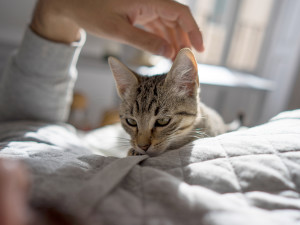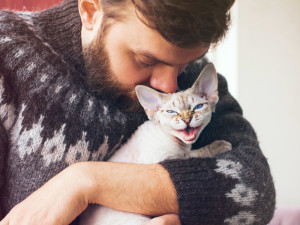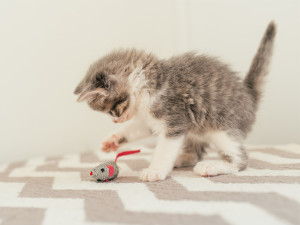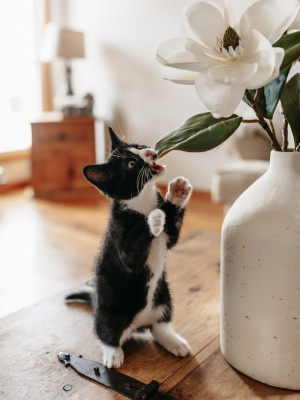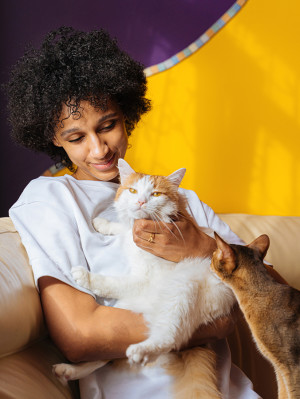Your Cat Hates It When You Frown
According to a new study, cats know what their parents’ facial expressions mean. Just, uh, FYI.

Share Article
People who think cats are indifferent— or even oblivious — to human emotions are probably still recovering from that time they attempted a cuddle session and got quickly rejected. Then, maybe their cat knocked their coffee off the kitchen table, just for added effect. But don’t be afraid to try snuggle time again; there’s actual scientific literature that suggests that if you’re happy your cat’s happy, too. That’s right, science (as it so often does) comes to the rescue to prevent our best friends from being maligned. According to research published in the journal Animal Cognition, cats act differently around their pet parents depending on the emotional state of those pet parents. In other words, they get us, and don’t let anybody tell you otherwise.
To Smile — Or Not to Smile
The cats in the studyopens in a new tab showed a modest difference in behavior when their parents showed facial expressions and posture associated with happiness compared with when their parents indicated anger with their facial expression and posture. When their parents acted happy, the cats responded with more purring, rubbing, and sitting on their laps. When their parents pretended to be angry, the cats did not reward their humans with as much affection. Interestingly, cats were just as likely to approach pet parents no matter if they were exhibiting positive or negative emotional expressions, but the cats showed more positive behaviors and more contact with their people when they were acting happy than when their people were showing signs of anger.

Get (totally free) deals for food, treats, accessories, tech, and way more pet parenting must-haves.
opens in a new tabThere was no difference in the behavior of cats when presented with strangers displaying different emotional states. This suggests that cats learn to associate the happiness of their pet parents with good experiences and the anger of their pet parents with experiences that are not favorable.
Researchers don’t understand why cats react to their parents’ emotions but not strangers’. It may take time for cats to learn the significance of these expressions and postures on their pet parents. They may not recognize the emotional expression on anyone else without practice, or they may be unable to generalize meaning of each expression from one person to another. It’s also possible cats give strangers the benefit of the doubt and are willing to be affectionate until further notice. See, there’s a different narrative than the Gloomy Gus people so often associate with the feline set.
You Can Work on Your Relationship
A better understanding of the interaction between people and cats offers us the opportunity to improve the relationship between our two species. The authors of this study are interested in pursuing more studies that investigate which cues cats use to predict human behavior and how these cues affect the attachment of cats to people.
They are also interested in the differences of cue-reading between cats who have been raised by humans since birth and cats who were rescued later in life — as was the case for the participants in this study. There are two essential elements of animals being sensitive to human cues: The first is being willing to accept them as companions, which often happens in the early stages of their life as young animals. The second is being able to learn that following human cues leads to good things.
So, anyone living with a cat should be mindful of the effect of your anger on your cat. No matter where that anger is directed, if it shows on your face and in your posture, it could keep your cat from cuddling up when you could really use a pal. But if you want your cat to leave you alone, go ahead and appear angry — because that’s what may happen.The best advice here, though: Turn that frown upside down and reap the feline rewards of exhibiting happiness.

Karen B. London, PhD, CAAB, CPDT-KA
Karen B. London, Ph.D., is a Certified Applied Animal Behaviorist and Certified Professional Dog Trainer who specializes in working with dogs with serious behavioral issues, including aggression, and has also trained other animals including cats, birds, snakes, and insects. She writes the animal column for the Arizona Daily Sun and is an Adjunct Professor in the Department of Biological Sciences at Northern Arizona University. She is the author of six books about training and behavior, including her most recent, Treat Everyone Like a Dog: How a Dog Trainer’s World View Can Improve Your Lifeopens in a new tab.
Related articles
![White cat switching on lamp on couch]() opens in a new tab
opens in a new tabWhy Does Your Cat Wake You Up at Night?
You want to sleep, your cat wants to party. Here’s how to deal.
![Dog on leash sitting on a colorful street and looking attentive at their pet parent]() opens in a new tab
opens in a new tabHow to Get Your Dog to Pay Attention to You
Here are some simple steps to pry your pup away from that one spot in the yard they’re obsessed with.
![A kitten playing with a mouse cat toy.]() opens in a new tab
opens in a new tabHow to Keep Your Kitten From Making You the Toy at Playtime
Your cat deserves to play. You deserve to walk away unscathed.
- opens in a new tab
How to Stop Your Cat From Munching On All of Your Precious Plants
Tips to get your cat to quit eating your greens.
![A woman with curly black hair sitting in front of a dark purple and yellow backdrop while looking down affectionately at her two cats sitting on her lap]() opens in a new tab
opens in a new tabHow to Build Your New Cat’s Trust in You
If your cat still approaches you with a figurative arched eyebrow of skepticism, try these tricks to put them at ease.
![Gray cat sniffing a glass on a shelf]() opens in a new tab
opens in a new tabHow to Scent Train Your Cat
A veterinarian on how nosework and scent enrichment can strengthen your bond.

